Apple has taken the second approach with caveats. Rumors suggest the iPhone 17 Air’s battery capacity will sit around 2,900 mAh, a steep drop from prior iPhone models, especially at the 6.6-inch screen size. But the company is supposedly making up for it with power-saving tricks to make sure battery life remains similar to other iPhones, including Apple’s more efficient C1 modem that debuted on the iPhone 16e earlier this year.
Luebbe declined to comment on whether Group14’s silicon-carbon composite is being used in the iPhone 17 Air’s batteries; Sila Nanotechnologies and Enovix did not immediately respond to a request for comment.
What’s the Catch?
The problem with silicon batteries is that they expand. When you lithiate raw silicon, Luebbe says it can expand up to three times its initial volume. Lithium-ion batteries also swell; you’ve probably heard of or maybe even experienced this, as it can happen for a myriad of reasons. It means something has gone wrong, and the battery is now a safety risk.
It’s this problem that researchers and companies have spent decades trying to solve, and the solution lies in the carbon part of the name. It starts to get a bit technical here—and each silicon anode company has its own proprietary process—but Luebbe says Group14’s approach is to start with a porous carbon material.
“Imagine a carbon sponge, but the pores of that sponge are on the single-digit molecule wide, we’re talking less than 10 nanometers wide,” he says. These pores are filled with silane gas (the silicon), but only about halfway. The particle you’re left with is made up of silicon, carbon, and void space. When the lithium ions head over from the cathode to the anode and the silicon lithiates, it expands to fill the void spaces of the particle.
“It mitigates the expansion at the particle level, so the battery doesn’t see the expansion, so it stabilizes the battery, and you get excellent cycle life,” Luebbe says. “That’s the critical insight in the invention: really learning how to internalize that expansion, so that it’s insulated from the battery chemistry and mechanical operations.”
Vincent Chevrier has been a researcher in the silicon field for 15 years and is a partner at battery consulting firm Cyclikal. He says while silicon is here to stay as a material to be used in lithium-ion batteries, there are still a few challenges for broader adoption, namely cost.
Companies like Group14 use silane gas instead of solid silicon, which yields better battery performance, but could be 10 times the cost. That could make it harder to sell their composite to battery makers, and it could drive up the prices of consumer electronics. The iPhone 17 Air is rumored to cost around $1,099, a potential $200 bump from the iPhone 16 Plus it’s expected to replace, though there could be other factors affecting its price, like tariffs.
Chevrier also says he often sees silicon-carbon makers inflate the energy density claims. Group14, for example, says on its website that its silicon batteries can deliver up to 50 percent more energy density than conventional lithium-ion batteries. But if the material is just dropped in to replace graphite and not much else is changed with the battery, you’re more likely going to see a 10 percent boost in energy density with a switch to a silicon-carbon anode. Redesign the battery cell, and then it’d be possible to see an increase of up to 30 percent.












